Arizona is a state well-known for its rich history and natural beauty. From the Grand Canyon to the red rocks of Sedona, there is no discernable end to the wealth of experience the desert state provides. Arizona is home to over 7 million people, making it the 14th largest state in the nation. Further, the capital city – Phoenix – carries the title of 5th largest city in the United States.

This southwestern state is famous for a lot of reasons, a few of which we will go over as we take a look at 6 of the fastest-growing counties in this beautiful state.
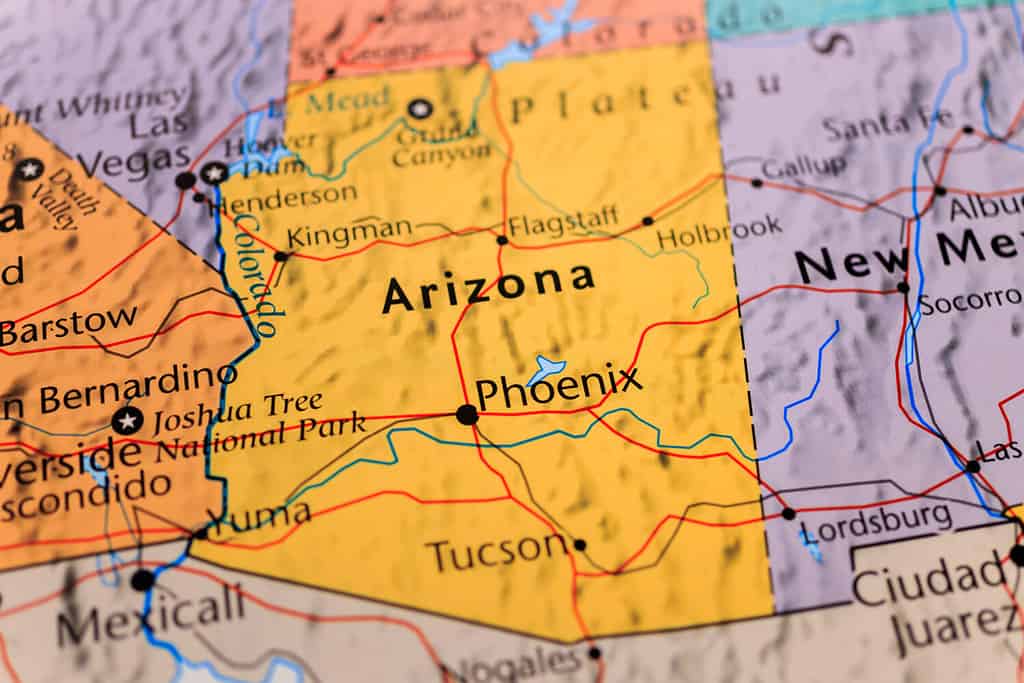
Phoenix is the state Capital of Arizona and the largest city in Maricopa County.
©Alexander Lukatskiy/Shutterstock.com
Measuring Population Growth
We use a standard formula to measure population growth. This formula calculates the percentage growth of a population over a given time. Here is the mathematical expression of the formula: Percentage Increase = [(Final Value – Initial Value)/Initial Value] × 100.
As an example, the population of Tempe, AZ, was 162,317 in 2010 and 184,118 in 2021. In order to calculate the growth percentage, subtract the total population in 2010 from the total population in 2021, then divide the resulting value by the 2010 population and multiply by 100. The result, 13.43 is the percentage of population growth in this time period. You can divide this number by the number of years between 2010 and 2021 to calculate the average annual growth rate of the city. In this example, we observe an average population growth of 1.2 percent over 11 years.
In order to get the most accurate picture of growth or decline, we measure population trends over a series of years. However, we can observe spikes in population due to specific events by looking at annual growth percentages. For this reason, we will note both annual and period-based growth for each county on this list. We used data from the United States Census Bureau website from between 2010 and 2022 to get our numbers, but keep in mind that the 2022 data is an estimate. The census only occurs every ten years – all population data outside of census years is an estimate.
It is important to note that population growth percentages are based on the current population size of a given area, and do not reflect overall population density.
Now that we’ve covered how we calculate growth, let’s take a look at each of our top counties.
1. Pinal County
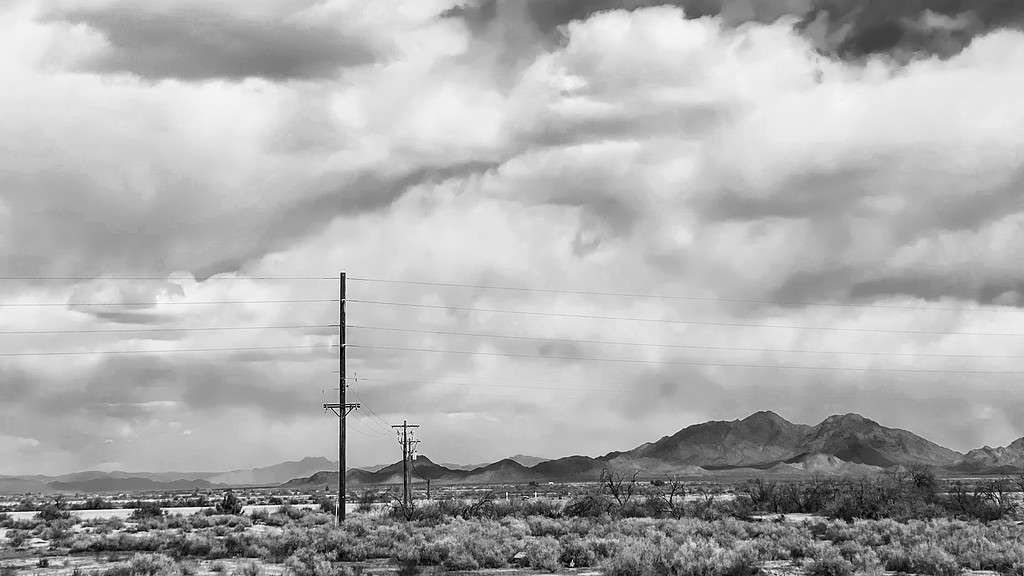
There are 12 different ghost towns in Pinal County, Arizona.
©Kevin Dooley / Flickr – License
- 2010 Population: 379,106
- 2022 Population: 464,154
- Population Change from 2010: +85,088
- Average Annual Growth Percentage: 1.89
- Total Growth Percentage: 22.43
- 3rd Largest County by Population in Arizona
- Largest City: Maricopa (62,720)
- Smallest City (Incorporated): Stanfield (515)
- Fun Fact: There are 12 different ghost towns in Pinal County.
2. Maricopa County
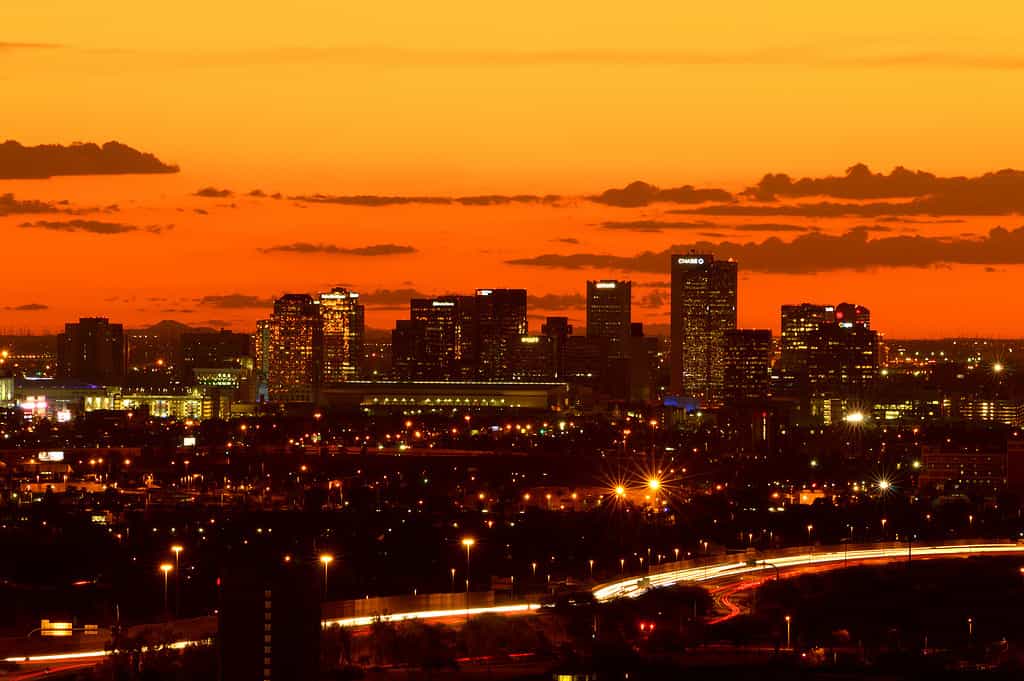
Phoenix, Arizona is the 5th largest city in the United States by population.
©iStock.com/gillcouto
- 2010 Population: 3,817,117
- 2022 Population: 4,551,524
- Population Change from 2010: +734,407
- Average Annual Growth Percentage: 1.60
- Total Growth Percentage: 19.24
- 1st Largest County by Population in Arizona
- Largest City: Phoenix (1,608,139)
- Smallest City (Incorporated): Gila Bend (1,892)
- Fun Fact: Maricopa County was the number one fastest-growing county in the United States from 2021-2022.
3. Yavapei County
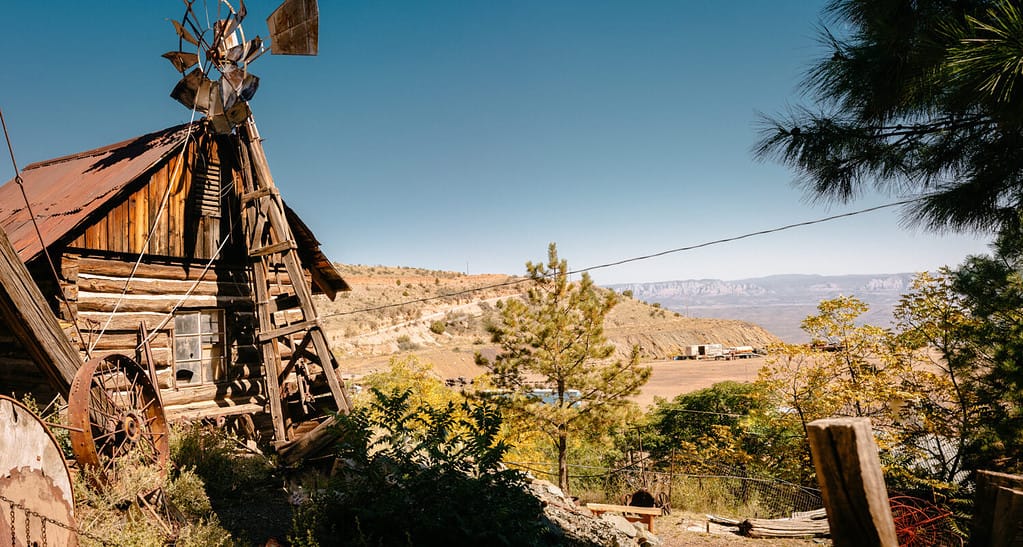
Gold King Mine and Ghost Town in Jerome, Arizona
©Atmosphere1/Shutterstock.com
- 2010 Population: 210,990
- 2022 Population: 246,991
- Population Change from 2010: +36,001
- Average Annual Growth Percentage: 1.39
- Total Growth Percentage: 16.68
- 4th Largest County by Population in Arizona
- Largest City: Prescott (39,843)
- Smallest City (Incorporated): Jerome (444)
- Fun Fact: Yavapei County gets its name from the Yavapei Tribe, which means “people of the sun”.
4. Greenlee County
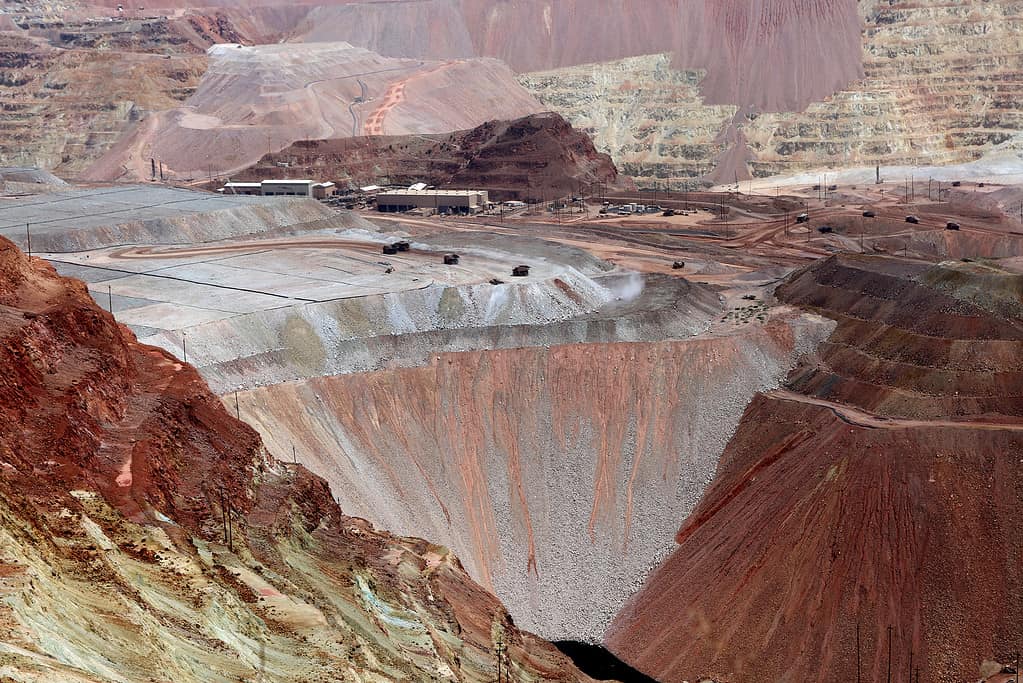
The Morenci copper mine is located in Greenlee County, Arizona.
©iStock.com/galinast
- 2010 Population: 8,342
- 2022 Population: 9,377
- Population Change from 2010: +1,035
- Average Annual Growth Percentage: 1.03
- Total Growth Percentage: 12.41
- 15th Largest County by Population in Arizona
- Largest City: Clifton (3,847)
- Smallest City (Incorporated): Duncan (677)
- Fun Fact: Greenlee County is home to North America’s largest copper mine – the Morenci mine in Morenci, AZ.
5. Mohave County
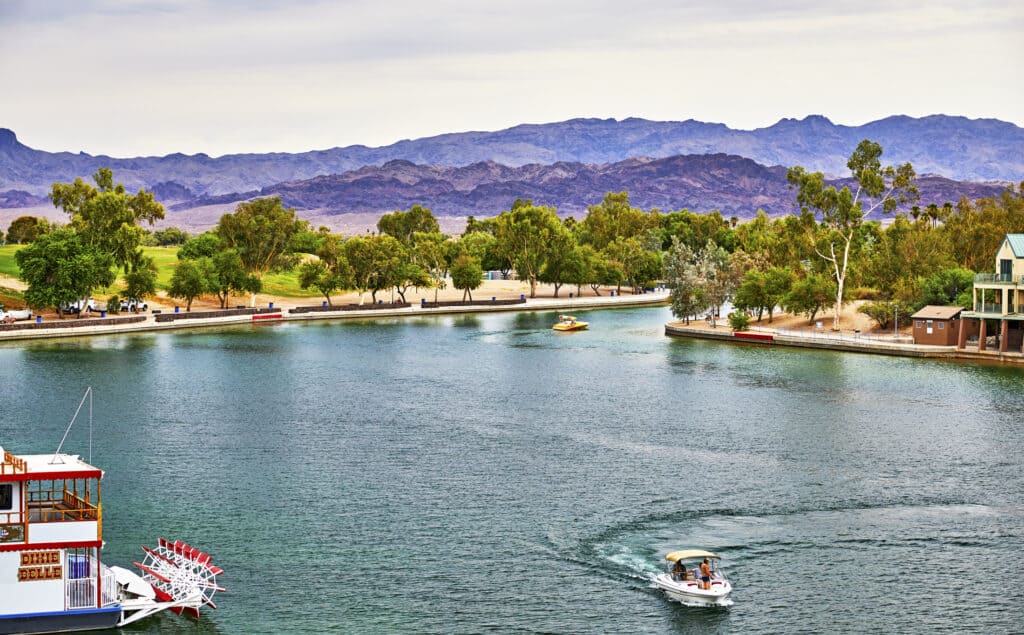
View from the London Bridge in Lake Havasu, Arizona.
©iStock.com/wingedwolf
- 2010 Population: 200,336
- 2022 Population: 215,883
- Population Change from 2010: +15,547
- Average Annual Growth Percentage: 0.65
- Total Growth Percentage: 7.76
- 5th Largest County by Population in Arizona
- Largest City: Lake Havasu City (58,284)
- Smallest City (Incorporated): Colorado City (2,520)
- Fun Fact: The original London Bridge that spanned the River Thames now lives in Mohave County. The 919-foot arch bridge is now a popular tourist attraction in Lake Havasu City.
6. Pima County
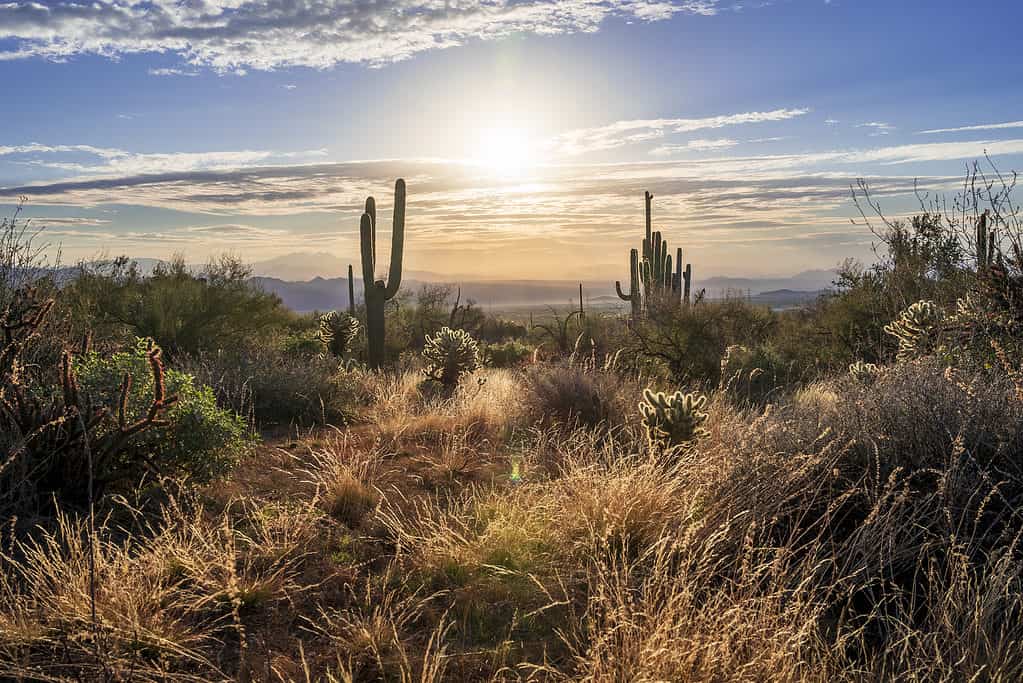
Saguaro cactus silhouette with sunrise over the Sonoran Desert.
©iStock.com/Eric Mischke
- 2010 Population: 981,649
- 2022 Population: 1,057,597
- Population Change from 2010: +75,948
- Average Annual Growth Percentage: 0.64
- Total Growth Percentage: 7.74
- 2nd Largest County by Population in Arizona
- Largest City: Tucson (543,242)
- Smallest City (Incorporated): South Tucson (4,585)
- Fun Fact: Pima County is home to the Arizona-Sonora Desert Museum in Tucson, a 98-acre indoor/outdoor experience dedicated to the protection and conservation of the Sonoran Desert.
A Brief Summary of Arizona’s History and Growth
Arizona officially became a U.S. state in February of 1912. Prior to incorporation, the state has over 10,000 years of indigenous history dating back to the paleo-Indian period. This history, which includes the existence and disappearance of several ancient civilizations, is one of the draws of this southwestern state. The table below lists some pivotal events in Arizona’s history, but will not provide specific information about each event. You can learn more about Arizona’s chronology by checking out the Arizona State Library website.
| Period | Length | Events |
|---|---|---|
| Prehistoric | 10,000 Before Common Era (BCE)-1400 Common Era (CE) | 10,000 BCE: First known inhabitants of Arizona 1276-1299 CE: Great Drought Circa 1400 CE: Prehistoric Cultural groups in decline |
| Spanish | 1528-1821 | 1540: Grand Canyon discovered by European settlers 1629: Missions in Hopiland become the first European settlements in Arizona 1775: Tuscon established 1810-1821: Mexican War of Independence 1821: Mexico gains independence |
| Mexican | 1821-1848 | 1846-1848: Mexican-American War |
| Territorial | 1848-1911 | 1848-1850: Arizona joins the United States as part of the New Mexico Territory 1881: Phoenix incorporated 1881: Showdown at the O.K. Corral 1906: Construction begins on Theodore Roosevelt Dam 1906: Landslide vote declines joint statehood with New Mexico 1911: Theodore Roosevelt Dam completed |
| Modern | 1912-present | 1912: Arizona joins Union and becomes the 48th state 1912: Women were granted suffrage 1914: Prohibition begins 1917: State flag adopted 1918: Spanish flu 1919: Grand Canyon becomes a National Park 1929: Great Depression 1930: Pluto discovered at Flagstaff’s Lowell Observatory 1930: Repatriation Movement begins first mass deportation of Mexicans and Mexican-Americans 1932: Prohibition ends 1946: Arizona becomes a right-to-work state 1946: Post-war population boom 1948: Indigenous Peoples of Arizona were granted the right to vote 1960: Population exceeds 1 million 1984: Population exceeds 3 million 1985: Largest Nuclear Energy facility opens in Arizona 2012: Arizona’s Centennial |
Wildlife in Arizona
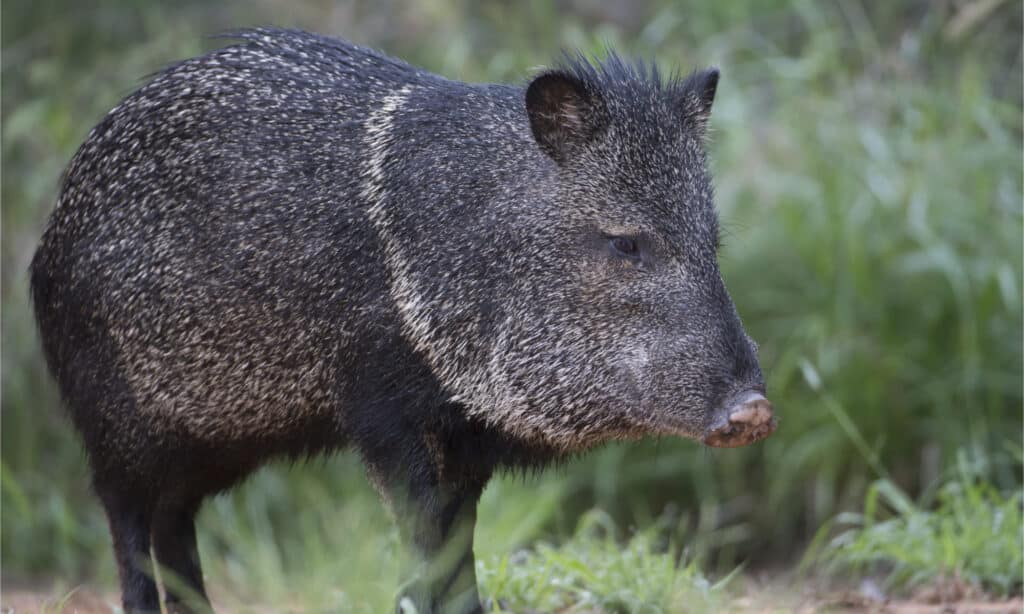
Javelinas may look like pigs, but they’re actually rodents.
©Dennis W Donohue/Shutterstock.com
There is no shortage of wildlife to see – over 1,000 different species are native to Arizona, including unique animals such as javelinas, desert tortoises, and burrowing owls.
Arizona has six different major biomes – grassland, chaparral, woodland, forest, tundra, and desert. A wide variety of biomes gives a wide variety of wildlife a perfect habitat to thrive in. It’s not just fauna, either. A large and distinctive collection of plants grow natively across the state. The Sonoran Desert is the only place in the United States where the ancient saguaro cactus grows.
Things to See in Arizona
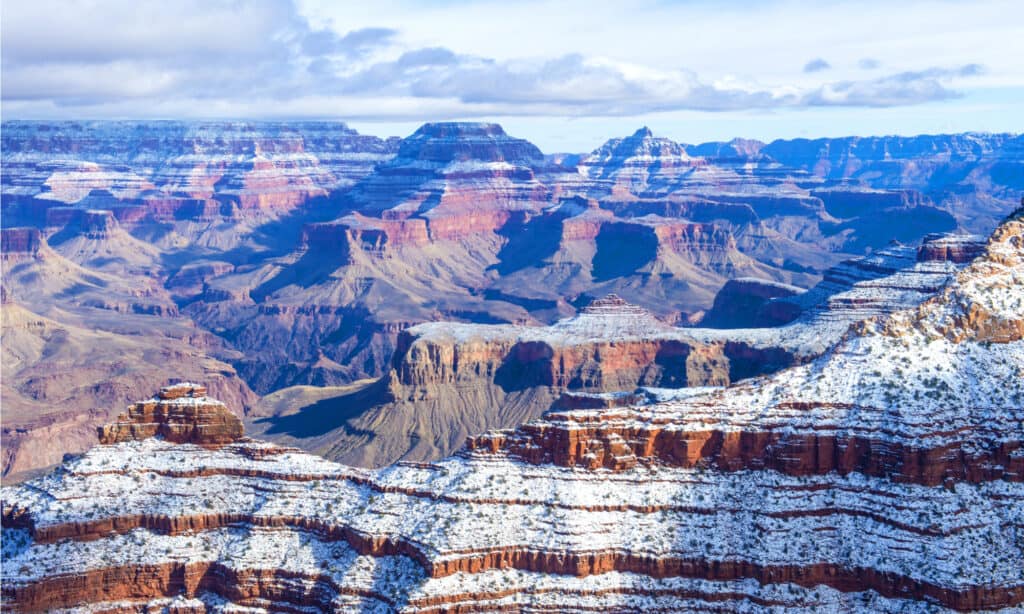
The Grand Canyon is Arizona’s best-known feature.
©Kobby Dagan/Shutterstock.com
Arizona has no shortage of destinations, from state parks to ghost towns and museums. Below is a non-exhaustive list of attractions to visit in the Grand Canyon State.
- Grand Canyon National Park
- Petrified Forest National Park
- Arizona-Sonora Desert Museum
- Saguaro National Park
- Sunset Crater Volcano National Monument
- Montezuma Castle National Monument
- The Phoenix Zoo
- Hoover Dam
- Havasu Falls
- The Arizona Science Center
- Lake Mead National Recreation Area
- Pima Air and Space Museum
- Arizona State Museum
- London Bridge
Food in Arizona
Arizona roots its culinary excellence in Indigenous tradition, and its food culture is all the better for it. Look up these famous Arizona foods if you visit or relocate to the state.
- Fry bread
- Sonoran hot dogs
- Arizona cheese crisps
- Medjool dates
- Chimichangas
- Prickly pear
Fastest-Shrinking Arizona Counties
On the other side of the population growth coin is population decline. Not all Arizona counties are popular choices for relocation. Three Arizona counties reported a significant decrease in their populations, and we have included them for comparison.
- La Paz County (-19.48 percent, or 3,993 people over 12 years)
- Apache County (-8.90 percent, or 6,396 people over 12 years)
- Cochise County (-4.67 percent, or 6,160 people over 12 years)
Summary of the 6 Fastest-Growing Counties in Arizona
| Rank | County | Annual Percentage Growth | Overall Percentage Growth | Overall Population (2022 est.) |
|---|---|---|---|---|
| 1 | Pinal County | 1.89 | 22.43 | 464,154 |
| 2 | Maricopa County | 1.60 | 19.24 | 4,551,524 |
| 3 | Yavapei County | 1.39 | 16.68 | 246,991 |
| 4 | Greenlee County | 1.03 | 12.41 | 9,377 |
| 5 | Mohave County | 0.65 | 7.76 | 215,883 |
| 6 | Pima County | 0.64 | 7.74 | 1,057,597 |
The photo featured at the top of this post is © GoodFocused/Shutterstock.com
Thank you for reading! Have some feedback for us? Contact the AZ Animals editorial team.






